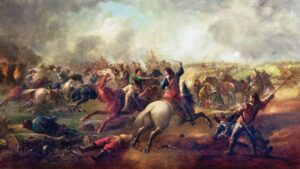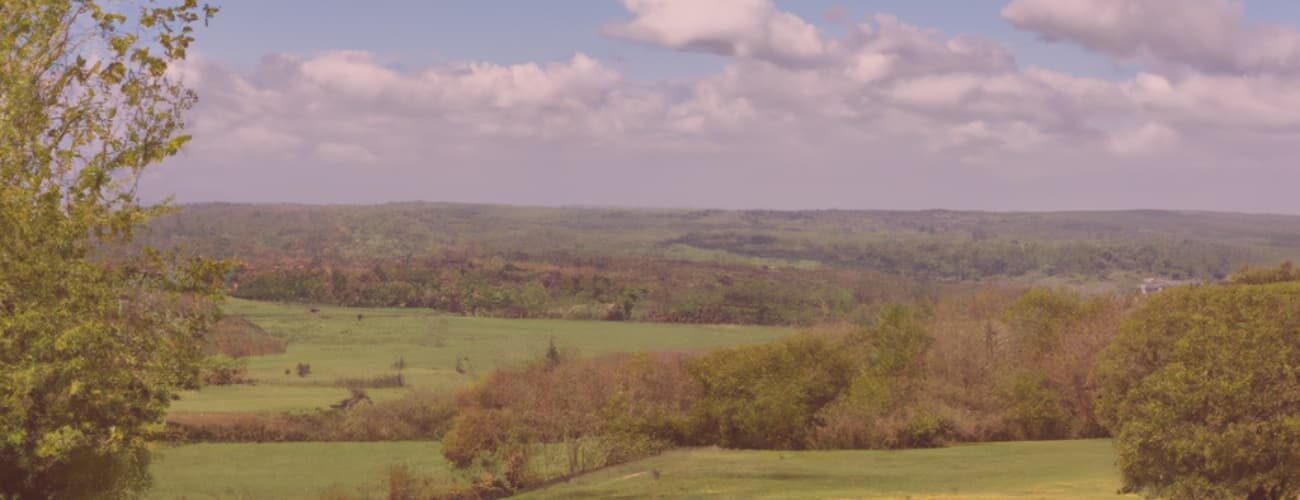•
(Caution: Contains spoilers for Episodes: S03E04: Beyond the Grave, S06E04: A Tale of two Hamlets, S08E04: Bantling Boy, and S11E02: Blood Wedding)
Diesen Beitrag gibt es auch auf Deutsch.
•
After the Gunpowder Plot, religious tensions in England continued to escalate against the Catholics. Among them were the Fitzroys of Bledlow Village, who took over ownership of their manor c.1610. This is what Harry Fitzroy told Ben Jones during his investigation…
The episode first aired in 2008, which means the Fitzroys have owned the manor since at least 1608, perhaps even before the Gunpowder Plot? Unfortunately, we don’t know from whom they acquired the manor.
The Grace of God
In 1625, James I was succeeded by King Charles I, who was even more committed to an absolutist monarchy. But he also sought reconciliation with Catholicism.
None of this appeased the many Puritans in Parliament. On several occasions, Charles I brushed aside concerns, petitions and so on. Things came to a head in 1640, after his plan to use royal troops to suppress a Scottish rebellion failed, and Parliament produced the Great Remonstrance. This was a list of all Charles I’s transgressions since 1625 – from the Puritan point of view. But Charles I felt so emboldened that he attempted a coup in January 1642, arresting Pym and other opposition leaders in the House of Commons.
But the coup failed. Charles I then fled to Oxford and the civil war began. The real leader of the Puritans was Oliver Cromwell. A Puritan with a very strong belief in Providence and the great-nephew of Thomas Cromwell (Dissolution of the Monasteries).
The origin of the enmity between the Upper and Lower Wardens
14 March 1643. According to the history books, it was not a decisive day in the Civil War, but for the inhabitants of the two villages of Lower Warden and Upper Warden, it was the beginning of a conflict that has lasted to the present day, and has only been exacerbated by the tug-of-war over the writer Ellis Bell and his famous book, House of Satan.
Frank Smythe-Webster also attends the press conference following the murder of the rather unpopular Larry Smith. Jack Wilson, who writes for the Upper Warden Church Newsletter and also runs the bookshop on the High Street, calls in. To Tom Barnaby’s astonishment, he does not have a question, but simply wants to point out to the press present that this is the appropriate time to talk about Ellis Bell’s affiliation. Just then, however, Frank Smythe-Webster’s phone rings and Gavin Troy asks Tom to come with him. Tom Barnaby and the others barely hear what Jack Wilson says. However, the Lower Warden bookseller explains that the enmity between the two chalets dates back to 14 March 1643 and Cromwell.
Jack Wilson could have explained what happened here in the early days of the Civil War, but Tom Barnaby interrupts him to go and see Gavin Troy. So we don’t know which of the hamlets was on the Royalist side and which was on the Parliamentarian side. But we do learn elsewhere that, irritatingly, Lower Warden is on a hill and Upper Warden is in the valley.
The Battle of Chalgrove
Perhaps the origins of the enmity lie in the Battle of Chalgrove, although this took place a few weeks later on 18 June 1643. Nearby are Watlington and Lewknor, the sites of Upper Warden and Lower Warden. Situated in Oxfordshire on the Chiltern Hills, they are 3 miles (almost 5 kilometres) apart, separated only by the hamlet of Shirburg. Both date from Anglo-Saxon settlements, but nearby ancient roads (now public footpaths) – Icknield Way and The Ridgeway – both date from the Iron Age and were also used in Roman times, archaeological evidence shows. After the Battle of Hastings, the Danish Thegn Tovi bequeathed his royal fief to Abingdon Abbey, which farmed it until its dissolution in 1538. Both towns were connected to the railway network from the second half of the 19th century.
During the Civil War, Watlington played a greater role as it housed Parliamentary troops. Even before the Civil War there were a number of Puritans, so the Roundheads were welcome here. The commander-in-chief of the Royal Cavalry was Rupert of the Rhine, Charles I’s nephew and an experienced and renowned soldier at the age of 23. He moved via Watlington and Lewknor to Chalgrove in June 1643, where he met Parliamentary troops seeking revenge for the siege of Reading. The battle consisted of several engagements which ended in a convincing Royalist victory.
Another possibility: The Battle of Hopton Heath in Staffordshire on 19 March 1643 was close in time to the enmity between the Upper and Lower Wardens, although this is a long way from the Midlands locations.
Battle of Marston Moor 1644 (08×04)

More than a year passed before the Battle of Marston Moor in the north of England on 2 July 1644 turned the Civil War on its head. The open field battle ended in a Parliamentary victory.
The Royalists’ defeat was all the more bitter because they had lost control of the north of England. The battle changed the course of the Civil War in the Parliamentarians’ favour, but they were unable to capitalise on it. Perhaps George Hartley, 4th Baron Bantling of Bantling Hall in Midsomer County, played a part in this. His descendant, Angela Hartley, tells Tom Barnaby in another episode that he fought for the Royalists but betrayed them at the Battle of Marston Moor.
The other two Hartleys portrayed, the Barons of Bantling, were similarly disloyal: as already mentioned, Cecil Hartley was part of the conspiratorial network around Guy Fawkes in the Gunpowder Plot of 1605. We are about to meet Thomas Bantling, who fought for the rebellious English colonies in the War of Independence, although he was a soldier in the English army. The place, Dorney Court in Buckinghamshire, also belonged to the Palmer family, who were loyal to the King. However, there was no treason here. The Palmer estates were seized in 1646, but returned in 1657. The family still owns the estate today.
The Secret of the Ring 2 and the synicate
Perhaps, now that little Peter has grown up, he will program a sequel to The Secret of the Ring computer game, but with all the historical men (the scallywags, according to Angela Hartley)? Perhaps with the addition of the characters around the syndicate and the Bantling Boy – and himself? Could be a Midsomer Murders bestseller. 😉
Battle of Aspern Tallow (03×04)
Almost exactly a month later, the Battle of Aspern Tallow took place in the middle of Midsomer County. Aspern Tallow was filmed in the Oxfordshire village of Ewelme, near the Chiltern Hills. It’s a former Roman and later Saxon settlement mentioned in the Domesday Book. Back then, in Norman times, Bigod, Earl of Wallingford was probably the owner of the village. And the film location is also related to the Civil War, as the manor was occupied by Prince Rupert. The nephew of Charles I was born in Prague, but grew up in what is now the Netherlands.
In the opening scene, Alan Bradford gives a tour of the parish to seven interested people, including Police Constable Angel, who is there in his spare time. He gives the tour from a Royalist point of view, although the Aspern Tallow area leaned Parliamentarian.
We learn that at 3.30pm on 1 August 1644 the Battle of Aspern Tallow was over and the Roundheads were victorious. Many, many Royalists died, but not Jonathan Lowrie.
Alan Bradford leads his group past a cottage, then along a footpath further into the village. But first he pauses to continue the story: Jonathan Lowrie was wealthy and in the King’s favour, but he had friends in Parliament. So he was able to make his way from the battlefield to his house in the hamlet down the lane where the group was standing.
Demolished
Alan Bradford is in the middle of the story when a bicycle bell rings and the group makes way for a tricycle on the pavement. Eleanor Bunsall, who will be in the spotlight a few more times in the episode, but not in relation to the Civil War. So we let her pass.
When the group reaches the graveyard of Aspern Tallow Church, Bradford tells how Jonathan Lowrie was discovered and wounded by the Parliamentarians here in the graveyard. He ran through the graveyard and was pursued by his attackers to his home, Aspern Hall. Alan Bradford’s party takes the same route, but not in a hurry. They reach Aspern Hall, now the local museum, and go inside to a stone slab in the ground. This is where Jonathan Lowrie was shot in the doorway of his house. The persecuted Royalist was still shouting his wife Florence’s name when he was fatally shot by one of the Parliamentary Musketeers. And in accordance with his wishes, he was buried where he died.
Bradford points to the ground, where a marble tombstone is embedded. But a shock awaits Alan Bradford as he leads the group into the hall where a very large painting by Jonathan Lowrie hangs. In the middle of a sentence, the local historian stops his story and stares at the large portrait of Jonathan Lowrie, recently demolished.
The next morning Tom Barnaby, Gavin Troy and Cully’s friend Nico Bentley are at Aspern Hall. Nico is accompanying Troy to rehearse his new role as Detective Sergeant in a play. Also present at Aspern Tallow are Alan Bradford, Sandra MacKillop and her brother-in-law Charles, as Alan Bradford leads them through the museum to the destroyed painting by Jonathan Lowrie. You can read on it: Jonathan Lowrie. Royalist, philanthropist, classicist.
To be continued – read part 2.
Read more about Midsomer Murders & History
The Chronology of Midsomer County by Year or by Episodes
Deep Dives into Midsomer & History
This is an independent, non-commercial project. I am not connected to Bentley Productions, ITV or the actors.

First published on MidsomerMurdersHistory.org on 19 January 2024.
Updated on 26 July 2025.


22 thoughts on “The Civil War, pt. 1”